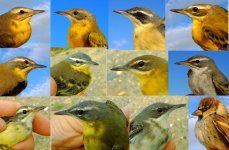Black Wheatear
Bowed but not broken, yet!
And the BTO - read the Ringer's Manual.
Photos are usually quite unecessary, and such things as 'record shots' etc are needless personal mementos. Unless the photos are for a specific purpose, such as training (close-ups of feather tracts etc, not a pretty pic of a raptor from 2 metres away) or publicity (which is really the BTOs remit, not individual ringers), then all they do is prolong handling and increase stress and the potential for harm to come to the bird (eg when changing grips etc when trying to present the best view).
The welfare of the bird ALWAYS comes first. That is the golden rule. But, imho, too many forget that in the quest for trophy shots. They're not needed, the manual says they should be avoided, and it makes some of the public question the reason why ringers do what they do. Which makes it bad PR.
I totally agree and I think most ringers that I know or have worked with feel the same.
I also agree that on handling techniques illustrated here, that no damage to the bird has been proven, so folk should concentrate on and stick to facts. Having said that, then I know of no ringers who handle raptors as illustrated, which does not prove one way or the other the perceived so called harmful technique shown.
It is a shame that falconbirder hasn't discussed his favoured technique on this thread, it would have been interesting and I am sure informative.





